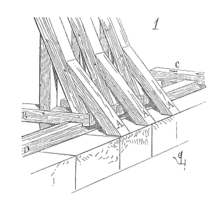Rafter
In recent buildings there is a preference for trussed rafters on the grounds of cost, economy of materials, off-site manufacture, and ease of construction, as well as design considerations including span limitations and roof loads (weight from above).
The earliest surviving roofs in Europe are of common rafters on a tie beam; this assembly is known as a "closed couple".
It is necessary always to order this special bill of rafters direct from the mill, and the result will be that the extra cost will, nine times out of ten, overbalance the amount saved.
[4] A piece added at the foot to create an overhang or change the roof pitch is called a sprocket, or coyau in French.
The projecting piece on the gable of a building forming an overhang is called a lookout.



